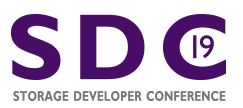It’s exciting to see the recent formation of the Solid State Drive Special Interest Group (SIG) here in the SNIA Solid State Storage Initiative. After all, everyone appreciates the ability to totally geek out about the latest drive technology and software for file systems. Right? Hey, where’s everyone going? We have vacation pictures with the dog we stored that we want to show…
Solid state storage has long found its place with those seeking greater performance in systems, especially where smaller or more random block/file transfers are prevalent. Single-system opportunity with NVMe drives is broad, and pretty much unquestioned by those building systems for the modern IT environments. Cloud, likewise, has found use of the technology where single-node performance makes a broader deployment relevant.
There have been many efforts to build the case for solid state in networked storage. Where storage and computation combine — for instance in a large map/reduce application — there’s been significant advantage, especially in the area of sustained data reads. This has usually comes at a scalar cost, where additional systems are needed for capacity. Nonetheless, finding cases where non-volatile memory enhances infrastructure deployment for storage or analytics. Yes, analytics is infrastructure these days, deal with it.
Seemingly independent of the hardware trends, the development of new file systems has provided significant innovation. Notably, heavily parallel file systems have the ability to serve a variety of network users in specialized applications or appliances. Much of the work has focused on development of the software or base technology rather than delivering a broader view of either performance or applicability. Therefore, a paper such as this one on building a Lustre file system using NVMe drives is a welcome addition to the case for both solid state storage and revolutionary file systems that move from specific applications to more general availability.
The paper shows how to build a small (half-rack) cluster of storage to support the Lustre file system, and it also adds the Dell VFlex OS implemented as a software defined storage solution. This has the potential to take an HPC-focused product like Lustre and drive a broader market availability for a high-performance solution. The combination of read/write performance, easy adoption to the broad enterprise, and relatively small footprint shows new promise for innovation.
 The opportunity for widespread delivery of solid state storage using NVMe and software innovation in the storage space is ready to move the datacenter to new and more ambitious levels. The SNIA 2019 Storage Developer Conference is currently open for submissions from storage professionals willing to share knowledge and experience. Innovative solutions such as this one are always welcome for consideration.
The opportunity for widespread delivery of solid state storage using NVMe and software innovation in the storage space is ready to move the datacenter to new and more ambitious levels. The SNIA 2019 Storage Developer Conference is currently open for submissions from storage professionals willing to share knowledge and experience. Innovative solutions such as this one are always welcome for consideration.